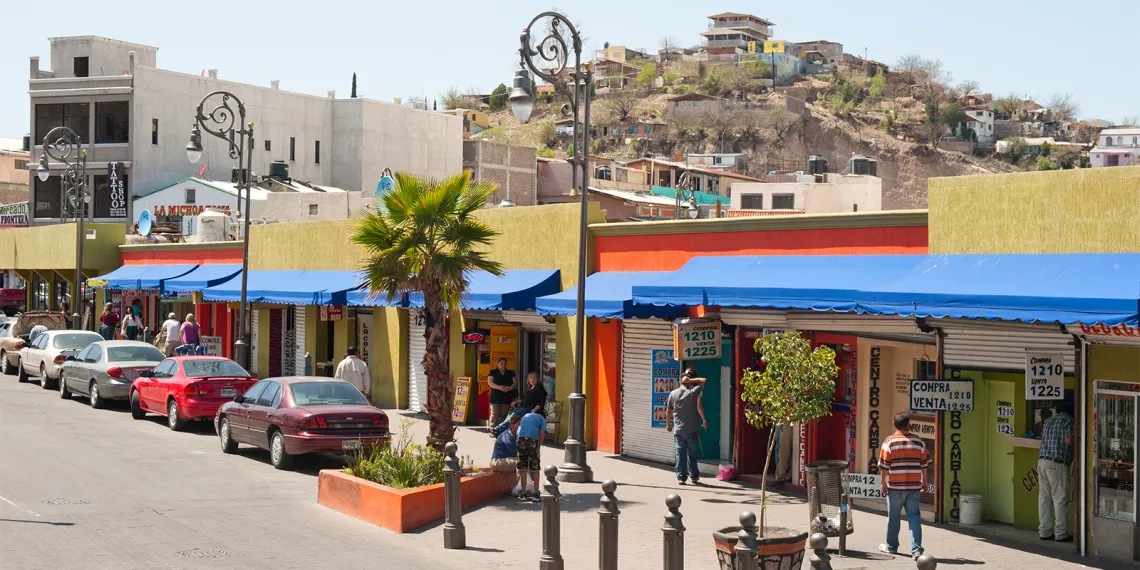While President Trump remains steadfast in his plan to build a wall along the border, his Mexican counterpart is rolling out economic initiatives to help reduce the need for emigration in the first place.
In the face of President Donald Trump’s plan to build a border wall, Mexican President Andrés Manuel López Obrador (AMLO) is approaching the issue of Mexican migration to the U.S. in another way.
On January 1, 2019, the AMLO administration enacted the “Northern Border Free Zone” or Zona Libre de la Frontera Norte, a 15.5 mile (25 kilometer) zone along the U.S.-Mexico border from the Pacific Coast to the Gulf of Mexico. Within the zona libre, sales taxes were cut in half from 16% to 8%, income taxes were reduced from 30% to 20%, and the minimum wage doubled to 176 pesos (~$9) a day.
AMLO hopes that implementing these changes in this 15.5-mile-wide zone will invigorate the Mexican economy and inspire Mexican workers to stay in Mexico. He is optimistic that the zona libre will “promot[e] investment, production and technological development, and the creation of jobs.” He calls it a “last curtain to retain workers in our territory.”
Daniel Martínez, assistant professor of sociology at the University of Arizona and affiliate of the Center for Latin American Studies, the Department of Mexican American Studies, and the School of Geography and Development, says that the changes within the zona libre may encourage direct foreign investment from the U.S., as well as cultivate binational economic hubs, but it is not clear if these new economic measures are going to practically address migration to the U.S.
“It’s possible” that the zona libre will curb migration, Martínez says, “However, international [unauthorized] migration is complex and is the consequence of several interrelated macro-, meso-, and micro-level factors, including ‘pull’ factors in the United States and ‘push’ factors in Mexico.”
Shifts in Migration
Those push and pull factors can be seen in reverberations from the North American Free Trade Agreement (NAFTA). Enacted on January 1, 1994, the trilateral tariff-free trade agreement between the United States, Canada, and Mexico set into motion devastating problems for Mexican farmers.
“Both campesinos and indigenous folks in the southern part of [Mexico] were displaced by NAFTA,” says Martínez, noting that the two groups often overlap.
This displacement created a pronounced northern migratory pattern from southern Mexico that did not exist prior. “Before this, most migration occurred from west-central Mexico to the United States.” But subsistence farmers in southern Mexico were forced “into urban areas and maquilas along the northern border, and into the U.S. in search of work.”
An attempt to energize the economy at the U.S.-Mexico border may not be the most effective approach to address the current migration crisis, especially since northern Mexican states like Sonora are already comparatively better off than states in southern and southeastern Mexico like Oaxaca from which the campesinos migrated.
Further still, unauthorized migration from Mexico by Mexicans is at near 40-year lows, said Martínez, and this has slowed even more in 2020 due to the coronavirus pandemic. The migration patterns to the U.S. have changed from the 1990s or 2000s when Mexican campesinos were pushed northward.
Today, migration consists mostly of Central American asylum seekers from the Northern Triangle—Guatemala, Honduras and El Salvador—who are “fleeing abject poverty, political instability, and perhaps most important, urban violence at the hands of gangs and corrupt officials in their home countries.”
A Public Health Crisis at the Border
Previously, President Trump threatened Mexico with tariffs, putting pressure on the AMLO administration to take concrete steps to address the migration crisis at the Mexico-Guatemala border. As a response to Trump’s threats, Mexico has added more security at its southern border, apprehending and detaining Central Americans heading north to the U.S. to seek asylum.
Martínez says that both the U.S. and Mexico’s attention should be focused on the factors driving this migration crisis from the Northern Triangle in the first place, factors for which the U.S. shares responsibility. “The U.S. government, since the early-1900s, has played an active role in destabilizing these counties, whether it be through banana republics, U.S. support for right-wing regimes, U.S. involvement in the Central American civil wars in the 1980s, the exportation of gang culture through our deportation policies, and most recently, the 2009 coup in Honduras.”
These factors have led to the destabilization of the Northern Triangle, pushing many Central Americans north through Mexico to make the dangerous trek to the U.S.-Mexico border—a journey that has become even more dangerous amid the pandemic, as social distancing and quarantine in refugee situations is nearly impossible.
Due to COVID-19, Migrant Protection Protocol hearings have been suspended until at least June, which has caused a further backlog in court proceedings. Many of those waiting along Mexico’s northern border with the U.S. not only face delays, but also live in cramped and unsanitary conditions, potentially exposing them to a greater danger of COVID-19.
Seeking asylum is a legal right set forth by international and U.S. immigration law. Yet, increased militarization of the border and U.S. programs like Operation Streamline and Prevention Through Deterrence have led to an increasing amount of incarcerations, deportations, disappearances, and deaths. The U.S. and Mexico have at its shared border a public health crisis, Martínez says.
“Let's keep in mind that migration from Mexico is near historic lows,” he says. “Rather, the focus should be on the Northern Triangle in Central America.”


